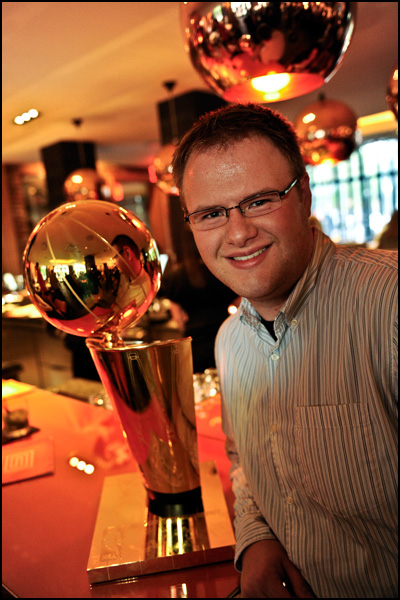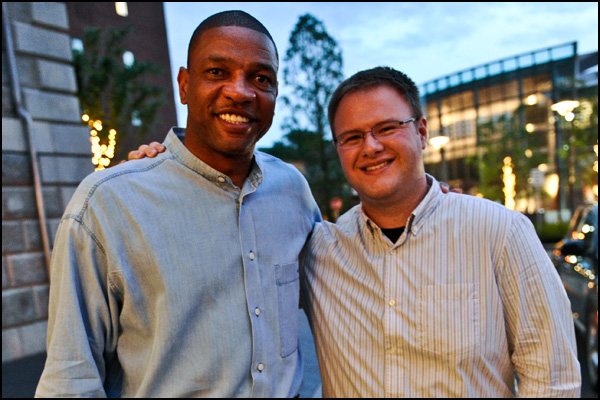6.25.2008
On Location: Boston
Last week, I was in Boston with Joe working on a high-volume commercial shoot. As he mentions at the end of this post, he shot over 200 GB in three days. To be exact, it was 258.57 GB, shooting RAW+JPG Basic.
Why JPG Basic and not Fine? Basic, being a smaller file, allows for faster transfer/download times, which is critical in a case like this. But it is still large enough for the client to view and make their selects from. The smaller files/faster transfer time also makes it more likely for me to be able to hand them a portable drive with the entire take before they leave location to return home. This saves me time in the long run as well, since it's one less thing I have to take care of upon returning to the studio, and also saves on shipping costs :)
This was a very fast-paced, exciting shoot. We were bombing around the city from one location to another each day (about five different locations each day, with a number of setups at each location). But about 75% of my time on location was spent sitting in a mini-van, downloading images to a laptop, while our second assistant, Rob Brown, was doing most of the grunt work.
My workflow for this particular shoot... Depending on the pace of shooting, I would let the cards (8 GB Lexar 300x UDMA) get down to about 50 frames or so remaining, then snag them from the camera, and replace them with fresh cards. I would then download them to the laptop (with Lexar's UDMA Firewire 800 readers, which are a Godsend!) Once they were downloaded to the laptop, I would then copy them to an external drive (also Firewire 800). Then I would copy them to another external drive. This way if I screwed up in one, or even two places, everything would still be on at least one drive. Only then would I format the cards. If we were transiting between locations, I would download as much as I could in whatever time the transit allowed for.
At the end of the day, I would sort everything in the laptop's folder by capture time (as opposed to filename, since we were shooting with three cameras), and rename the files. I also added Joe's copyright to the metadata. Once the metadata was finished, I would then re-copy everything to the external drives, replacing the original files.
If you haven't noticed already, the key in all of this is speed, speed, speed. This is why we opted for the smaller-but-faster 200GB 7200 RPM hard drive (as opposed to the 250GB 5400 RPM drive) when getting a new laptop. The faster I can get cards downloaded, backed up, and formatted, the longer Joe can shoot without interruption... Which means we finish shooting earlier, get back to the hotel to shower and change clothes more quickly, get to dinner sooner, get back to the hotel sooner, and get to sleep earlier. Every minute counts when your day begins between 4-5 a.m. and ends around 11 p.m.-midnight.
It may sound like I was taking the easy way out, letting Rob do all the heavy lifting while I sat in the van, but that's not really the case. Think about it like this... You spend a lot of time working on a particular shot, and the client is watching the entire time, so they have a really good idea of what they're going to see when they look at the pictures. The time comes for them to make their selects, and they start browsing through the take. But they have a particular setup in mind that they are looking for... They scroll and scroll, hoping to come upon it at any moment, but they never see what the money shot. Where is it...?
"Oh, that card was accidentally formatted before it got downloaded."
Or...
"The camera's filename structure started over, and some of the original frames got overwritten by the newer ones."
Or...
"A homeless guy mugged me and took all the cards!"
Whatever. It doesn't matter.
The point is, card and image management is one of the most important parts of the job. And when three different cameras are being used, all of which have two cards in them, that makes it all the more challenging to keep things in order. While it may not seem like hard physical work, it can be very stressful mentally. One wrong click or keystroke, and everything can go away in a matter of milliseconds. Including the trust the client had in you and your reputation.
Luckily, everything went well and everyone had a great time. Especially at dinner the night after the Celtics beat the crap out of the Lakers...


posted by Brad @ 11:56 AM,
,
![]()
![]()
6.10.2008
Mistakes - Part 1 of Many
Everyone makes mistakes.
I am no exception to this fact. My mistakes are many, and I have no doubt that I will continue to make mistakes as long as I have breath in my lungs. My most recent mistake (as an assistant, that is) happened less than a couple of weeks ago...
A week before it happened, Joe had planned on going into the city (NYC) for a shoot. He'd given me a pack list, which I took, packed everything, and double checked. I was just finishing things up when he came out and told me that the shoot had been postponed until the following week.
No big. Just leave everything packed and we'll be ready to go when next week rolls around, right...?
During the course of the week, things inevitably get moved around, somewhat unpacked, etc. The day of the shoot rolls around again, and I load up the truck with what had already been packed, loosely checking to make sure we still had everything. Looks good.
We get into the city, fight through traffic, and arrive at our destination. Get out, make chit chat with the people we're going to be shooting (friends of Joe's), then start to figure out how we're going to set things up. The shot Joe has in mind calls for firing the camera remotely via Pocket Wizards.
Guess what Joe's genius assistant had put in their own small bag and sat on top of the camera bag (which I moved during the week) during the initial pack, then overlooked when he was re-loading the truck the following week...
CRAP.
If there's one thing that I have learned from Joe since I've been working with him, it's that every problem has a solution. In addition to that, he has a policy to "never let 'em see you sweat," which he talks about in his book, The Moment It Clicks.
We immediately begin brainstorming to find a solution...
Have a car service bring the Pocket Wizards into the city from the studio in Connecticut? Too time consuming...
It's Friday evening... Who is still open...?
Joe gets on the phone and finds a store across town that's open for another hour and has some in stock. I jump in the truck and "race" across town (as quickly as I can in Friday evening NYC traffic, going through Times Square), and make it to the store with time to spare. Grab the Wizards, hop in the truck, and get back to location where Joe is already under way getting things set up.
Hook up the Wizards, do some test firing, and we're good to go.
The rest of the shoot goes pretty smoothly, and Joe was able to get some great pictures (but then again, when does he not?)
So, the lesson here is that you should ALWAYS double, triple, and quadruple check your pack to make sure you have EVERYTHING you might possibly need. Something Joe learned from Alfred Eisenstadt... It does you no good if it's back at the studio.
If there's one thing that I have learned from Joe since I've been working with him, it's that every problem has a solution. In addition to that, he has a policy to "never let 'em see you sweat," which he talks about in his book, The Moment It Clicks.
We immediately begin brainstorming to find a solution...
Have a car service bring the Pocket Wizards into the city from the studio in Connecticut? Too time consuming...
It's Friday evening... Who is still open...?
Joe gets on the phone and finds a store across town that's open for another hour and has some in stock. I jump in the truck and "race" across town (as quickly as I can in Friday evening NYC traffic, going through Times Square), and make it to the store with time to spare. Grab the Wizards, hop in the truck, and get back to location where Joe is already under way getting things set up.
Hook up the Wizards, do some test firing, and we're good to go.
The rest of the shoot goes pretty smoothly, and Joe was able to get some great pictures (but then again, when does he not?)
So, the lesson here is that you should ALWAYS double, triple, and quadruple check your pack to make sure you have EVERYTHING you might possibly need. Something Joe learned from Alfred Eisenstadt... It does you no good if it's back at the studio.
posted by Brad @ 5:45 PM,
,
![]()
![]()
6.02.2008
Pascal Dangin - Retoucher Extraordinaire
A friend of mine recently sent me a link to this article from The New Yorker about one of the industry's top retouchers (though from the article, it sounds like he might be the top retoucher), Pascal Dangin.
With a client list that includes American Express, Vanity Fair, W, Harper's Bazaar, Annie Leibovitz, etc., you know this guy knows his stuff. He is the founder of Box Studios, which is a retouching house and high-end digital photography studio.
As the article states, he isn't credited in magazines, but he is the go-to guy for the fashion industry and celebrities when they want to make sure their images look their absolute best.
It's interesting to see how this one person has shaped the world of digital photography so much just by his "style" of retouching. It's not a particular style, though. It's his ability to conform to the needs of a particular client, and being so good at it that his style is being a master of being good.
Labels: editing, post, retouching
posted by Brad @ 4:07 PM,
,
![]()
![]()